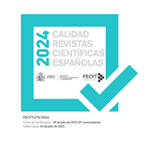Tipología de mecanismos cognitivos y lingüísticos que caracterizan el léxico disponible
Resumen
Se presenta una tipología de mecanismos que explica las relaciones entre las unidades léxicas y conceptuales de seis centros de interés (CI) o campos temáticos −Partes del cuerpo, Prendas de vestir, Alimentos y bebidas, Ciudad, Profesiones y oficios y Escuela y útiles escolares− del léxico disponible de estudiantes bogotanos. La tipología plantea la existencia de algunos mecanismos, agrupados en dos grandes conjuntos: semántico-cognitivos y lingüístico-formales, que subyacen a la activación del léxico disponible de la población de estudio. El análisis realizado parte de los fundamentos de la teoría de las Redes Semánticas (semantic networks) y emplea la herramienta informática DispoGrafo para determinar la red de unidades léxicas y conceptuales que conforman cada CI. Se presenta la distribución de estos mecanismos en el corpus, junto con una definición e ilustración mediante grafos de cada uno de los mecanismos propuestos.
Descargas
Descarga artículo
Licencia
La revista Círculo de Lingüística Aplicada a la Comunicación, para fomentar el intercambio global del conocimiento, facilita el acceso sin restricciones a sus contenidos desde el momento de su publicación en la presente edición electrónica, y por eso es una revista de acceso abierto. Los originales publicados en esta revista son propiedad de la Universidad Complutense de Madrid y es obligatorio citar su procedencia en cualquier reproducción total o parcial. Todos los contenidos se distribuyen bajo una licencia de uso y distribución Creative Commons Reconocimiento 4.0 (CC BY 4.0). Esta circunstancia ha de hacerse constar expresamente de esta forma cuando sea necesario. Puede consultar la versión informativa y el texto legal de la licencia.











